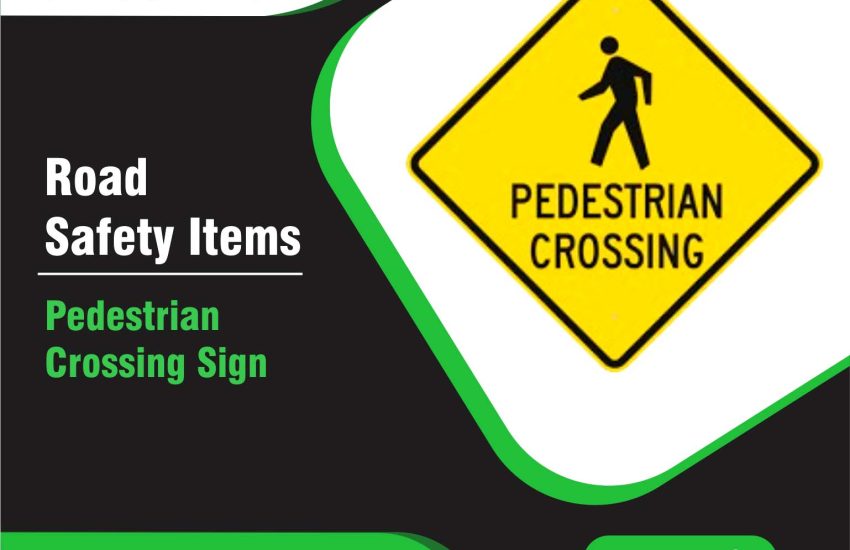Pedestrian Crossing Sign play a vital role in ensuring road safety for pedestrians. These traffic control devices alert drivers to pedestrian activity in crossing zones. By increasing driver awareness, they help prevent accidents and promote safer streets. This article discusses the key specifications, benefits, and features of pedestrian crossing signs, explaining why they are essential for modern traffic systems.
What is a Pedestrian Crossing Sign?
A pedestrian crossing sign indicates a designated area where pedestrians are likely to cross. It provides visual cues to both drivers and pedestrians, ensuring a smooth flow of traffic while protecting those on foot. Typically, these signs display symbols like a walking person or text such as “CROSSING” or “PEDESTRIAN”. They are common near intersections, schools, and other busy pedestrian areas.
Key Specifications of Pedestrian Crossing Signs
- Material Pedestrian crossing signs are made from high-quality aluminum, steel, or engineered plastic. These materials resist rust and corrosion, even in harsh weather conditions, ensuring long-term durability.
- Size and Dimensions The size of these signs typically ranges between 600mm to 900mm in height or diameter. The standard dimensions of pedestrian crossing signs are often 600mm x 600mm or 750mm x 750mm, providing maximum visibility without being too obtrusive.
- Reflective Surface A reflective surface is a key feature of pedestrian crossing signs. This makes the sign highly visible during the night or in low-light conditions. Reflective sheeting, like 3M™ Scotchlite™, enhances visibility by reflecting light from headlights.
- Colors and Symbols These signs are typically yellow, green, or fluorescent yellow-green, with high-contrast black pedestrian symbols. The bright colors improve visibility, while the clear pedestrian symbol ensures that both drivers and pedestrians understand its purpose.
- Durability and Weather Resistance Pedestrian crossing signs are built to withstand a variety of weather conditions. They are UV-resistant, water-resistant, and highly durable, maintaining their clarity and functionality over time.
- Mounting and Installation Pedestrian crossing signs are mounted on sturdy poles at eye level for easy visibility. They can be installed using bolts or screws for secure placement. Some signs may feature adjustable brackets for customized installation.
- Compliance with Standards These signs must comply with local regulations, such as the Manual on Uniform Traffic Control Devices (MUTCD) in the United States or international guidelines. Compliance ensures that the signs meet safety and legal standards.
Benefits of Pedestrian Crossing Signs
- Enhanced Pedestrian Safety The primary benefit of pedestrian crossing signs is that they protect pedestrians. These signs increase awareness, helping drivers slow down and watch for pedestrians at busy crossing areas.
- Improved Driver Awareness Pedestrian crossing signs keep drivers informed of pedestrian traffic, reducing the likelihood of accidents. When drivers are alerted to crossings, they can adjust their speed and be more cautious.
- Durability and Longevity Pedestrian crossing signs are designed to endure extreme weather and heavy use. The durable materials and reflective coatings ensure the signs maintain their effectiveness for years, reducing the need for frequent replacements.
- Cost-Effective Solution Installing pedestrian crossing signs is an affordable way to improve safety without breaking the budget. The signs are low-maintenance and have a long lifespan, making them a cost-effective investment for traffic control.
- Increased Compliance with Traffic Laws By installing pedestrian crossing signs, communities ensure compliance with national and international traffic safety standards. This reduces the risk of legal issues and enhances the overall safety of road systems.
Common Applications of Pedestrian Crossing Signs
- Intersections Pedestrian crossing signs are commonly installed at intersections with high foot traffic. These signs alert drivers to the potential presence of pedestrians, reducing the risk of accidents in these areas.
- School Zones Schools often use pedestrian crossing signs to protect children crossing streets. These signs are often more visible, with extra reflective materials and larger symbols, to ensure that drivers remain cautious.
- Residential Areas In residential neighborhoods, pedestrian crossing signs are used to guide pedestrians and alert drivers to slow down. These areas may have pedestrians walking to parks, community centers, or bus stops.
- Shopping Districts High-traffic shopping districts often require pedestrian crossing signs to protect shoppers moving between stores or crossing busy streets. These signs ensure that vehicles are aware of pedestrian traffic, especially in retail zones.
- Construction Zones During construction, pedestrian crossing signs are necessary to safely reroute pedestrians around construction sites. They provide clear instructions on where pedestrians should cross and help keep them away from hazardous zones.
Conclusion
Pedestrian crossing signs are a crucial part of traffic management. They improve pedestrian safety, increase driver awareness, and help communities meet traffic safety standards. With their durable materials, reflective surfaces, and clear symbols, these signs ensure that both drivers and pedestrians can safely navigate busy areas. Whether placed at intersections, school zones, or shopping districts, pedestrian crossing signs enhance road safety for everyone.
Investing in pedestrian crossing signs is a simple yet effective way to reduce accidents and promote safer streets. These signs provide a cost-effective solution that ensures both pedestrians and drivers stay informed and alert, reducing the risk of accidents and improving overall traffic flow.


